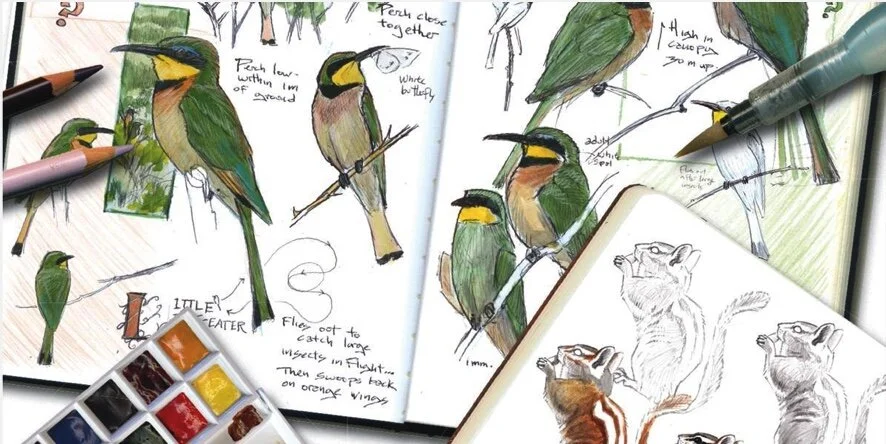7th June 2020
Ecosystems
John Muir Laws offers his workshops for free. If you would like to donate to help support his amazing work you can do so here.
What is an ecosystem?
An ecosystem is all the living and non-living things in an environment interacting together. This means animals, plants, fungi and bacteria all interacting with the non-living elements of the system, such as wind, heat, weather, landscape, stones and soil…An ecosystem is a complex and beautiful network of elements.
An ecosystem can be big, like a forest, or as small as a decaying log or pile of stones. A suburban backyard is an ecosystem which can be documented in your journal. Start with one species and think about how that connects with another, and before you know it you have begun to discover the web of life around you!
In an ecosystem, living things have different roles to play. The roles of living organisms in an ecosystem are sometimes broken down into three groups: Producers, consumers and decomposers. Plants are producers because they produce their energy from an external source, the sun. Animals are consumers because they consume plants or other animals to gain nourishment. Fungi and bacteria are important for recycling nutrients back into the ecosystem by decomposing organic matter, so they are considered decomposers. When you’re looking at your ecosystems today, think about these three groups and whether you can spot an example of each!
Field sketching ecosystems
Come on a sketch-walk with Bethan Burton (Journaling With Nature),
journal in a forest ecosystem and discover the interactions
between different organisms in the environment.
Bethan Burton is a passionate nature advocate and the founder of International Nature Journaling Week. To learn more about her work visit her website journalingwithnature.com.
Marine ecosystems
Elizabeth Mills (MArine Mumbles) shares a very special video today - nature journaling in a rockpool ecosystem:
Please remember to subscribe to Elizabeth’s Marine Mumbles YouTube channel. Each subscriber increases her amazing channel’s visibility on YouTube and helps her get found by other marine loving nature journalers.
Here’s a great example of a journal page showing part of a tidal rock pool ecosystem from Jean Mackay.
Nature journaling prompts and ideas
Explore an ecosystem near you. It could be a terrestrial ecosystem such as a forest, a grassland, or even a local park, or it could be an aquatic ecosystem such as a creek or a tide pool by the sea.
Think about the producers, consumers and decomposers in your chosen ecosystem. Can you see evidence of these different types of organisms interacting with each other and with the environment? How could you capture this in your journal?
You can also explore an ecosystem on a micro scale. Try to identify a micro-ecosystem near you. It could be the organisms you find when you turn over a rock or it could be the life that you can find on a single tree truck. You might like to try parting the grass on your lawn or at the park and seeing what you find there. You will be surprised how much life you can find when you take a moment to look.
We are nature. Check out the bigger picture by looking back over your journal this week, at the plants, animals and fungi you’ve recorded, and where they were. You can start to understand their places in the ecosystems they belong to, and how these systems also inter-relate! It’s simply fascinating, and a good reminder of how all life is connected through nature.
Paula Peeters (Paperbark Writer) shares her adventures with underwater ecosystems in her blog post ‘Underwater nature journaling adventure’.
You’ll find inspiration for journaling your own ecosystem from the images of Robin Carlson. Check out the gallery of panoramic panels on her website.
Martina Innocenti has generously given us some lifecycle printable PDFs for children to learn from and colour.
Click on the words below each image to download the PDF
Learn more
The whole surface of our Earth is a series of connected ecosystems. Why not take a look at your own local ecosystems and see how they fit in? Or, you can create one - and help wildlife too! Here are some ideas…
There’s a great, illustrated, explanation of ecosystems and how they work here from National Geographic.
There are lots of ideas on You Tube for creating your own ecosphere, or maybe a terrarium. Why not give it a try?
Wildlife gardening helps to encourage the diversity of species in your patch, and supports the ecosystems right on your doorstep. You could build a bug hotel, add a log pile for amphibians, or simply let a patch of grass and wildflowers grow… You can add features to your patch to encourage creatures of all kinds. The Wildlife Trusts in the UK have lots more ideas for creating homes for nature, here.
Creating a water feature will bring all sorts of new life to your garden. Why not follow their ideas, put in a pond, and see what happens?






















